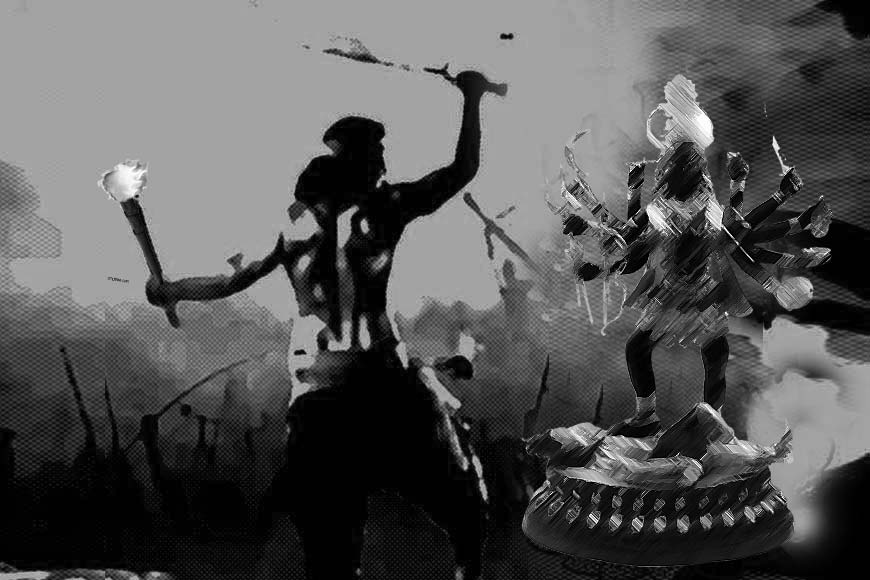Mashaals herald Kali Puja of Malda following rituals of dacoits - GetBengal story

Kali Puja aka Shyama Puja or Mahanisha Puja is just round the corner and when the entire country gears up to celebrate Deepavali, the festival of lights, in eastern India, the new moon day (Dipannita Amavasya) heralds the arrival of Goddess Kali, a major Hindu goddess. She is the deity of darkness, destruction, and death as well as the symbol of Mother Nature because she is believed to be timeless and formless, representing the creation of life and the universe as well. In northern India, people celebrate Diwali as the day of King Rama’s return to Ayodhya after defeating Ravana by lighting rows of clay lamps. Southern India celebrates it as the day that Lord Krishna defeated the demon Narakasura. In western India, the festival marks the day that Lord Vishnu, the Preserver (one of the main gods of the Hindu trinity) sent the demon King Bali to rule the nether world. In eastern India, the new moon day (Dipannita Amavasya), Goddess Kali is worshipped at night with tantric rites and mantras. Her ferocious and fearsome depiction conceals her loving, motherly persona. Above all, Kali takes away the fear of death and blesses one with liberation, the ultimate goal of human life, the ultimate freedom from all sufferings, beyond which nothing exists. Kali is the first of the 10 Mahavidyas in the Hindu tantric tradition.
From the second half of the 18th century to the first half of the 19th century, Kali was widely patronized by armed gang of robbers (dacoits) in Bengal. In fact, ‘Dakat Kali thaan’ (temples of dacoits) were commonplace in villages across Bengal. But why did dacoits had allegiance to this particular deity alone? This had to do with the socio-economic life of Bengal that was severely affected by the oppressive rule of East India Company officials and ruthless landlords who usurped land of poor farmers. Left with no options, many poor villagers were forced to take up arms and battle against their oppressors and lead the life of brigands. These fearless outlaws were inspired by Goddess Kali, the quintessential embodiment of shakti, the female power. They worshipped her as an independent goddess who is a scary, a bloodthirsty embodiment of destruction, and the ultimate protector against evil. Stories and myths of Kali-bhakta (devotees) dacoits galore and renowned authors like Hemendra Kumar Roy and Maharani Suniti Devi have written about the blood-curdling exploits of the fearless bandits like Raghu Dakat, BisheDakat, Manohar Dakar et al.
Also read : Moida Kali! Well, she is not made of flour
One such Kali Puja is organized annually during Deepavali at Manikora, a small non-descript village under Habibpur police station in Malda district, where mythology and history are interlaced and one cannot be separated from the other. The 300-year-old Puja is celebrated with immense devotion by pious worshippers. Locals insist that centuries ago, the deserted, densely forested area was the home ground of fierce brigands who used to cross the fast-flowing Punarbhava River to arrive at Manikora in the pitch-dark ‘Amavasya’ (New Moon) night to perform Kali Puja. They used to complete all rituals and then retreat to their safety isle before daybreak. This was long, long ago. Since then, times have changed and so have the people but the ancient tradition set up by the outlaws continue and ‘mashal’ (torches) are lighted at night before the puja rituals begin. This tradition continues to enthrall not only locals but also those who visit the holy shrine during the annual event.
It is believed that during British rule, a local landlord discovered the remains of a discarded dais in the forest and decided to revive the Kali puja at the site. Since then, the descendents of the zamindar family organized the annual event on a large scale where all devotees were encouraged to participate. At present, this puja has turned into a community event, hosted by villagers. A seven-day-long fair is held in the adjacent field of the temple. A giant clay sculpture of the goddess is made and its measurements remain unchanged every year. In the past, buffalos were sacrificed at the deity’s altar during puja but now instead, goats are sacrificed.
There is a very interesting story related to this deity that villagers never tire of repeating to the uninitiated. It is said that once a conch shell bangle seller walked the lanes and by-lanes of the village selling his wares. Suddenly, a young girl approached him and requested him to help her wear a pair of conch shell bangles. The man obliged and then asked for payment. The girl said since she did not have any money with her, she asked him to go to the temple priest who happened to be her father and seek the payment from him. The seller went to the temple and asked the priest for payment, the priest was surprised since he did not have any daughter. He was on the verge of spilling the beans when suddenly he noticed a young girl swimming in a nearby pond who lifted her hands to show her newly-bought pair of conch shell bangles. The wise priest instantly realized the girl was none other than Goddess Kali herself. He was overwhelmed, saluted the idol, and then paid the seller.
There is hearsay about the Kali idol here. People say, in the past, during oblation, the statue of the goddess used to shake violently and tilt forward dangerously. In fact, it was customary to tie up the deity with iron shackles to prevent it from falling. Nowadays during the ritual of sacrifice, the idol’s face is covered with a piece of cloth. Locals have immense faith on the celestial powers of the goddess and they firmly believe she protects them from all evils. In fact, before any auspicious event in the village, it is still customary to offer Puja to the goddess. Apart from special puja held every Saturday and Tuesday, Goddess Kali is worshipped with utmost piety in the month of Kartikeya (October-November). Following ancient tradition, torches are lit in the same way as was done by the dacoits centuries ago before initiating the rituals. During the few days preceding the Puja, all the villagers turn strictly vegetarian. Devotees from different parts of the state and even from abroad visit the temple to offer prayers.










